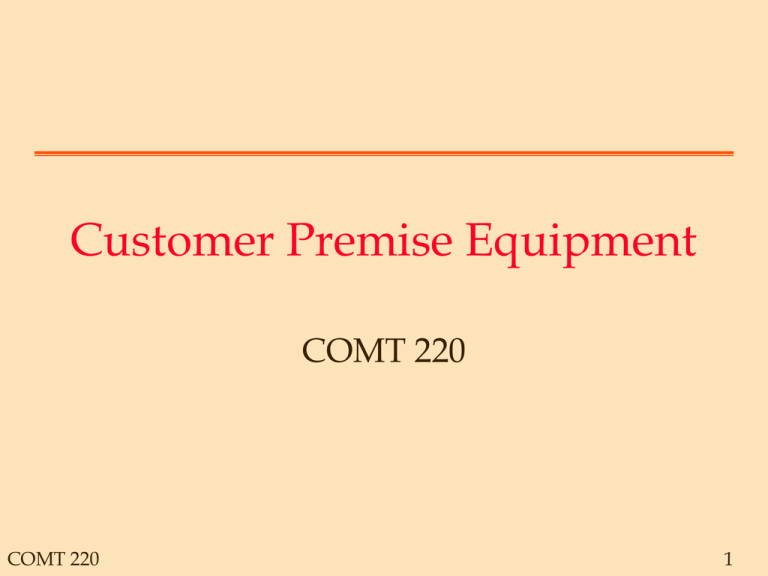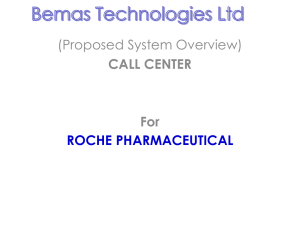220-Lecture
advertisement

Customer Premise Equipment COMT 220 COMT 220 1 Definitions • CPE - Customer Premise Equipment – Correctly defined as “anything the customer connects to the network” – In practice we use CPE to mean “equipment other than simple terminals” (phones, PCs, etc.) • We will discuss mainly voice, but the arguments apply to video and data also COMT 220 2 Rationale • Placed between End-Users and CO connections • Provide on-premise functions • Make cost-efficient use of CO connections User User CPE CO User COMT 220 3 Different Types… • PBX - Private Branch Exchange – Full Premise Based Switching • Key System – Smaller System, usually non-switching – Difference to PBX often unclear • CENTREX – PBX functionality, but implemented in the Central Office Switch COMT 220 4 Switching Principles and Methods COMT 220 5 Cross-Point Switching “Space Division Switching ” 1 4 1 COMT 220 4 6 Three-Stage Switch COMT 220 From Stallings, Voice and Data Communications. 7 Time Division Switching • Each Line Card “Samples” the inbound signal (8000 times per second, each sample is taken over 0.125 msec) • While the cards collect the next sample (during the next 0.125 msec), the Time Slot Interchanger collects all samples and delivers them to the correct line card outputs • The TSI must process 8000*2*(number of conversation) samples COMT 220 8 Time Division Switching TSI COMT 220 9 PBX “Block Diagram” Analog Phones Digital Phones L I N E S Special Workstations SMDR IXC Special Access Private Lines Administration Maintenance COMT 220 PBX Switching System T R U N K S Local Switched Access CTI 10 Packet Switching? Analog Phones Digital Phone L I N E S PBX Switching System T R U N K S Digital Phone COMT 220 11 Categories of Features • Features for the System User (Internal Customer) • Features for the System Administrator • Features for the Caller (External Customer) COMT 220 12 Handling Outbound Calls • Call destination restrictions • Least cost route selection • Automatic redial COMT 220 13 Handling Inbound Calls • Routing Calls – Attendant – Direct Inward Dialing • Handling Unanswered Calls – – – – COMT 220 Call Forwarding -- General Call Forwarding -- Busy/No-Answer Hunt Groups Queuing and Message Services 14 Handling Unanswered Calls • Hunt Groups • Queuing • UCD – Universal Call Distributor • ACDs – Specialized PBX software for inbound call handling COMT 220 15 PBX Capacity • Traffic (usually measured in call minutes per hour) – How Many Simultaneous Calls • Processor – Total Calling Volume – Busy Hour Call Attempts • Physical Interfaces – Stations and Trunks COMT 220 16 “Programming a PBX” • Moves, Adds, and Changes (MAC) – Establish New Service – Disconnect Service – Change Features On Existing Service COMT 220 17 Adding an Analog Station • Physical Install • Assign Extension Number • Assign Class of Service and Other Features – Often uses a template (or “Table”) A B C COMT 220 1234 18 Adding a Digital Phone • Physical Installation • Define Feature Buttons on the Digital Phone • Define Line Appearance Buttons • Assign Extension(s) to Line Appearances • Assign Class of Service COMT 220 19 Button Assignments A B 1 C 2 4 1 2 5 7 * 3 6 8 0 9 # 3 COMT 220 20 Button Assignments Hold A B Xfer 1 C 4 Line 2 1 2 Line 1 2 5 7 * 3 6 8 0 9 # 3 COMT 220 21 Extension Assignments A B Hold 1234 5678 Xfer C 1 4 1234 1 2 5678 2 5 7 * 3 6 8 0 9 # 3 COMT 220 22 Extra Slides COMT 220 23 Multi-Stage Crosspoint Switching - Concept COMT 220 24











